|
|
|
|
|
|
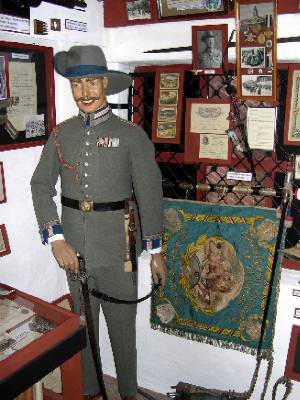 |
|
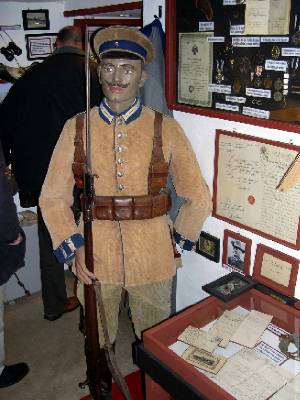 |
|
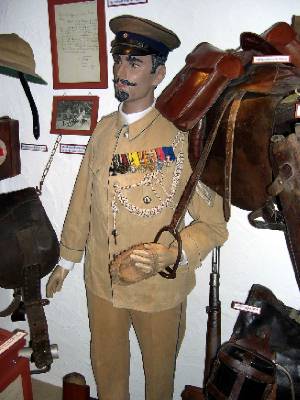 |
The photograph above left shows a South West African Schutztruppe
1897 Home Uniform as worn by a Sergeant (note the rank lace on the collar
and cuffs). The uniform is in grey cloth with blue piping, collar and
cuffs. On the right breast is worn a sharpshooters lanyard in twisted
imperial colours-
black/white/red. On the left breast we see several medal ribbons including,
from left to right, the 1914-18 Honour Cross for Combatants (with the
badge of the Colonial Lion Order), the South
West Africa Campaign Medal (for the Herero Rebellion 1904-08) and a
third Bavarian medal. The headgear is a traditional Schutztruppe
Südwester in grey felt with blue hatband and edging.
Confusingly this figure has the belt buckle and bayonet (with
NCOs bayonet knot in imperial colours) as worn by the rank of Sergeant and
below, while also carrying the sword worn by the ranks of Vizefeldwebel
and above. The sword presumably comes from a different soldier.
The blue banner in the lower background is from a Colonial War Veterans Union
("Kolonialkriegerverein").
The photograph above centre shows a
South West African Schutztruppe 1896 Corduroy
Uniform as worn by the South West African Schutztruppe on active
service in cold weather. The uniform consists of a Kord Waffenrock
with blue piping, collar and cuffs. The trousers are matching khaki
corduroy. The peaked cap is also in matching corduroy with a blue
hatband and piping and a single imperial cockade. The equipment worn
is the standard type for personnel in South West Africa.
The photograph above right shows a South West African Schutztruppe 1896
Khaki Uniform as worn on active service in hot weather. The tunic and
matching trousers are piped in blue. On the left arm can just be
seen the three chevrons of a Vizefeldwebel. On the right breast he wears
parade cords in black/white/red for NCOs and an impressive medal display including,
from left to right, the Iron Cross, the 1914-18 Honour Cross for
combatants, the Württemberg Military Merit Medal in Silver, the China
1900-01 Campaign
Medal for combatants, the South West Africa 1904-07 Campaign Medal with three
campaign bars in bronze for combatants, the Württemberg long service
medal issued in white metal for nine years service and the Prussian
first class long service medal for 21 years service (much of which
was probably earned on double time for colonial service). The peaked field cap is in grey to match the home
uniform with blue hatband and piping for South West Africa and a single
imperial cockade on the front.
|
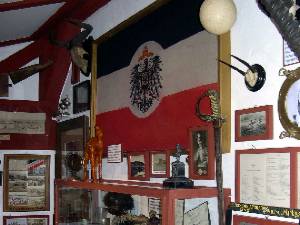 |
|
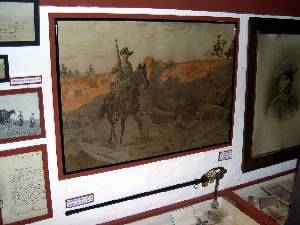 |
|
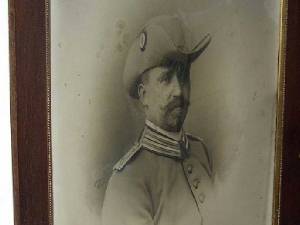 |
|
A display of many items from the colonies
dominated by a large imperial flag. This is the company flag from the 7th
South West African Schutztruppe Field Company, the famous "Camel
Riders". Herr Linke, the owner of
the museum in Rödelsee, is the grandson of Vizefeldwebel
Leonhard Köberlein of the 7th Company who saved the flag after the
South West African surrender in 1915.
Other items seen here are
photos, documents and antelope horns from Africa. |
|
A display including a print of a painting
by Carl Becker showing a horseback Schutztruppe trooper. |
|
A display including a photograph
of an officer (possibly a Major of the Medical services-
Sanitätstruppe) Note the broad
officers' Litzen on the
collar. |
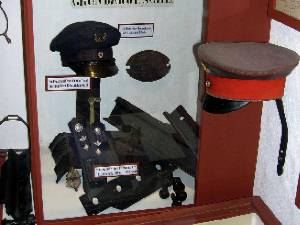 |
|
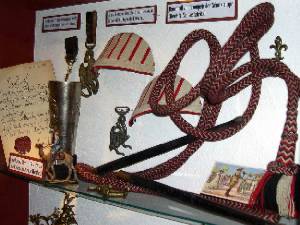 |
|
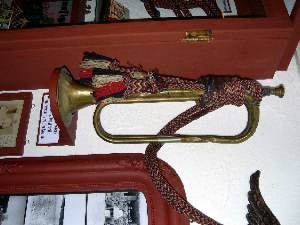 |
|
A display including the shoulder boards and
peaked cap of a train or transport NCO in South West Africa (note the
winged wheel badge above the imperial cockade) on the left and a
Schutztruppe pharmacist (Apotheker)'s peaked cap on the right
(defined by the red hatband and piping and officials' imperial eagle
above the cockade). |
|
A display including a written draft for
510 Reichsmarks to the Schutztruppe commander in South West Africa on the left, a pair of the "swallow's nest"
shoulder insignia worn by native Schutztruppe or Polizeitruppe
musicians in East Africa, Cameroon and Togo in the centre and a
bandsman's black/white/red twisted instrument cord on the right.
|
|
A cavalry bugle used by the Schutztruppe in
South West Africa. Note the cord in twisted black/white/red. |
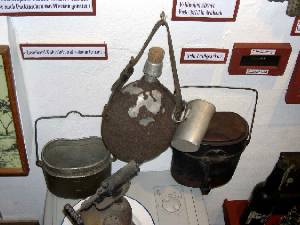 |
|
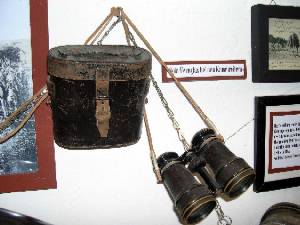 |
|
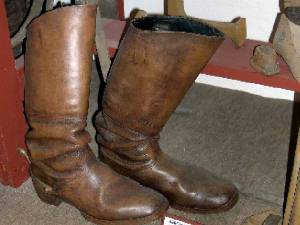 |
|
Various bits of kit used by the South West
African Schutztruppe including two canteens and a felt
covered aluminium water bottle with a cork stopper. |
|
A pair of field glasses with their
carrying case commonly used by officers in the South West African
Schutztruppe. |
|
A pair of riding boots as were standard
issue to the Schutztruppe in South West Africa. They were usually worn
with a leather strap attached over the front to fix the spurs in
place. |
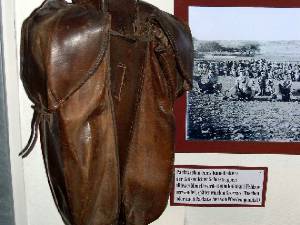 |
|
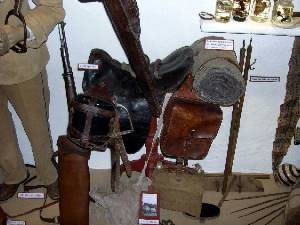 |
|
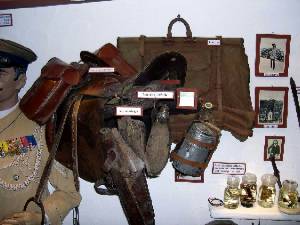 |
|
A pair of camel bags used by the South
West African Schutztruppe |
|
A horse saddle with full kit used by the
South West African Schutztruppe |
|
Another horse saddle used by the South
West African Schutztruppe |
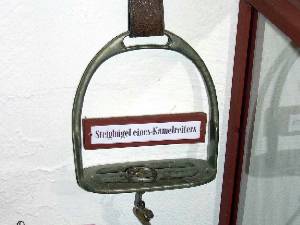 |
|
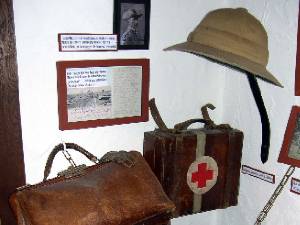 |
|
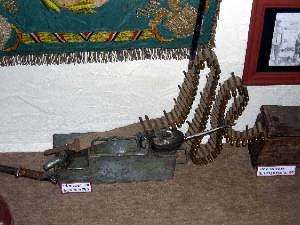 |
|
A stirrup used by the South West African
Schutztruppe camel riders. |
|
Medical bags used in South West Africa.
The tropical helmet is also from South West Africa, although not of
Schutztruppe issue it may have been used by a doctor or colonial
official. |
|
A Machine gun belt and ammunition boxes
for the Maxim Machine gun used by the South West African Schutztruppe.
The Germans first used Maxim machine guns during the Herero Rebellion in
South West Africa to devastating effect. |
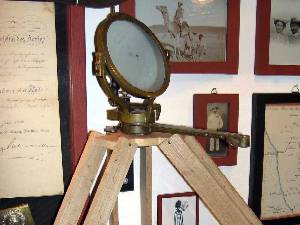 |
|
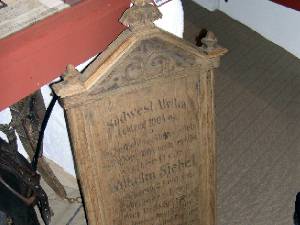 |
|
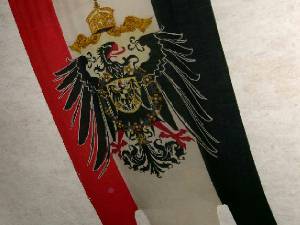 |
|
A heliograph communications system used by
the South West African Schutztruppe. |
|
A wooden commemorative plaque for
Schutztruppe Gefreiter Wilhelm Siebel who died on November 26th 1904
in South West Africa. |
|
A three pointed imperial flag of the type
used to drape outside buildings. This one was once used outside the
Colonial Ministry Office (Reichskolonialamt) in
Berlin. |
|
|
|
|
|
|